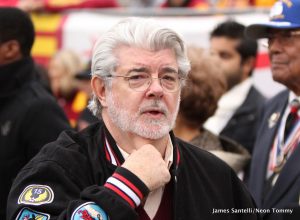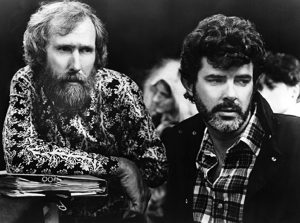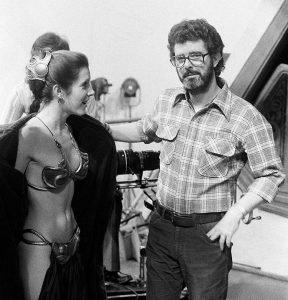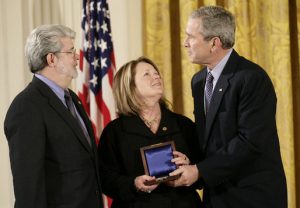George Lucas is a writer, producer and director who became world-famous for ‘Star Wars’ and ‘Indiana Jones’ movie franchises. He revolutionized film industry with unconventional screenplays and special effects, inspiring many generations.

image source: https://search.creativecommons.org/photos/ccb4e6bb-af0d-4488-a5e7-739579dfa1d6 by Neon Tommy
Filmmaker George Lucas’ devotion to timeless storytelling and cutting-edge innovation has resulted in some of the most successful and beloved films of all time, while also pioneering new digital standards for sophistication in film visuals and sound and inspiring generations of young people to follow their imagination and dreams.
About his Career
George Lucas was born on May 14, 1944, in Modesto, California. In 1966 Lucas received a bachelor’s degree from the film department of the University of Southern California in Los Angeles. Lucas made several highly acclaimed student films, including the futuristic parable Electronic Labyrinth THX 1138 4EB, which won first prize at the 1967-68 National Student Film Festival.
In 1967, he was awarded a scholarship by Warner Brothers to observe the making of Finian’s Rainbow (1968) which was being directed by Francis Ford Coppola. Lucas and Coppola became good friends and formed American Zoetrope in 1969, but when Coppola went into production for The Godfather (1972), Lucas formed his own company, Lucasfilm Ltd.
Inspired by the suburbs he grew up in, he directed American Graffiti (1973) which won the Golden Globe and garnered five Academy Award nominations. This gave him the clout he needed for his next daring venture. From 1973 to 1974, he began writing the screenplay which became Star Wars (1977). He was turned down by several studios until 20th Century Fox gave him a chance.

image source: https://en.wikipedia.org/wiki/George_Lucas#/media/File:Lucas_-_Henson_-_1986.jpg
The movie went on to break all box office records, earned seven Academy Awards and redefined the term “blockbuster”. He went on to produce several more movies that have introduced major innovations in filmmaking technology, such as the Indiana Jones film created with Steven Spielberg, which made box office records of their own.
From 1980 to 1985, Lucas was busy with the construction of Skywalker Ranch, built to accommodate the creative, technical, and administrative needs of Lucasfilm. In 1986, the animation studio Pixar was founded as the Graphics Group, one third of the Computer Division of Lucasfilm, reaching pioneering developments in visual effects.
In 1991, The George Lucas Educational Nonprofit Foundation was founded to celebrate and encourage innovation in schools. The Foundation’s content is available under the brand Edutopia, in an award-winning web site, social media and via documentary films. After finishing his series and collaborating on other groundbreaking films, he retired in 2012 when he sold Lucasfilm to Disney.

image source: https://search.creativecommons.org/photos/821423f2-5380-4510-b9e4-b0d64122f69b by Sal Ami
Innovations in film
Besides his directorial and production work on movies, Lucas is one of the most significant contemporary contributors to modern movie technology. In 1975 Lucas established Industrial Light & Magic (ILM) in Van Nuys, California, which was responsible for the invention of the special computer-assisted camera crane “Dykstraflex” that was used for most of the space fight sequences in the Star Wars movies.
Through ILM, Lucas spurred the further development of computer graphics, film laser scanners and the earliest use of 3D computer character animation in a film, Young Sherlock Holmes(1985). Lucas is also responsible for the modern sound systems found in many movie theaters. Though Lucas didn’t invent THX, he is responsible for its development.
Lucas departed from the traditional cameras and production system by filming Star Wars: Episode II Attack of the Clones completely digitally. He showed the result to a select audience of the Hollywood elite, before the movie’s general release. For the presentation, Lucas used a special digital projection system. The attendees said the movie had the clearest and sharpest presentation they had ever seen.
Lucas was also influential in the development of industry-standard post-production tools such as the Avid Film and Video non-linear editor, first developed as the Edit Droid, and the Sound Droid, which later became the Digidesign Pro Tools sound editing and mixing software.

image source: https://en.wikipedia.org/wiki/George_Lucas#/media/File:George_Lucas_Medal_of_Technology.jpg
info source: https://en.wikipedia.org/wiki/George_Lucas
